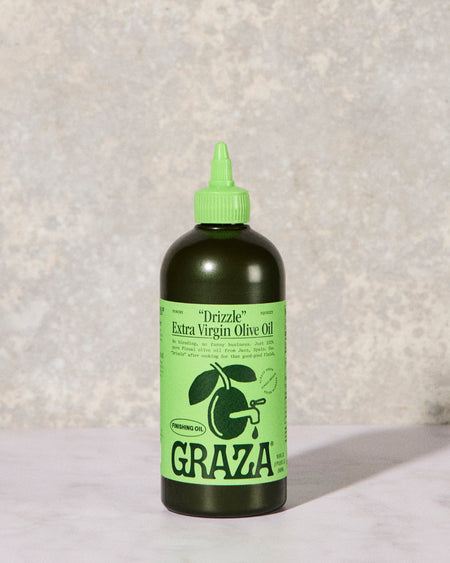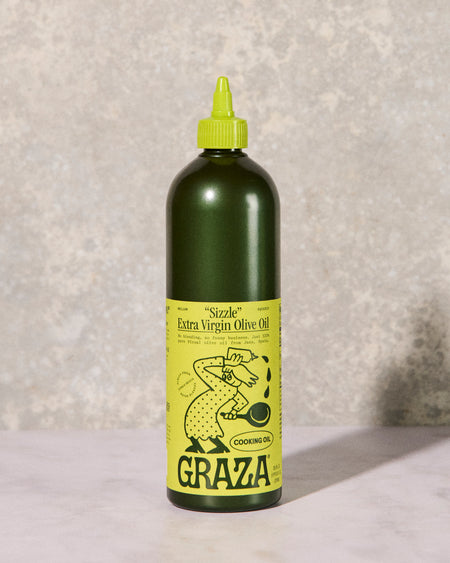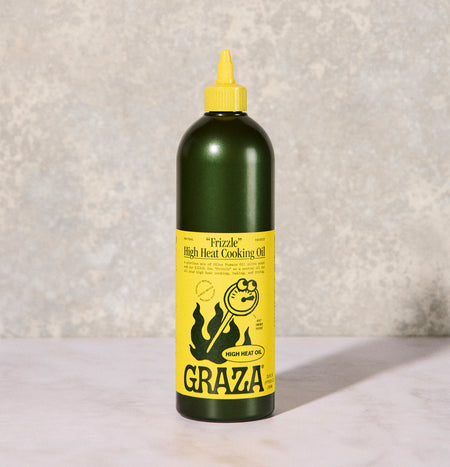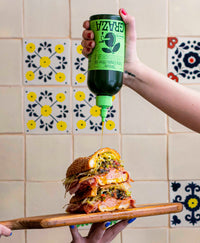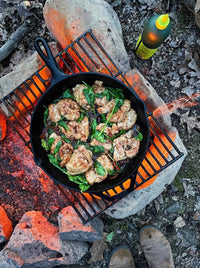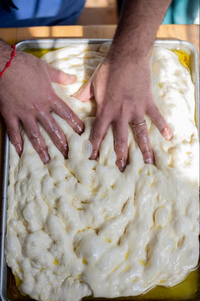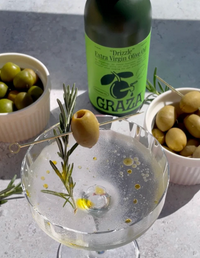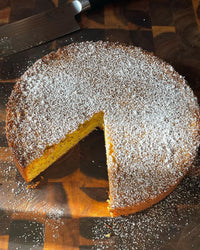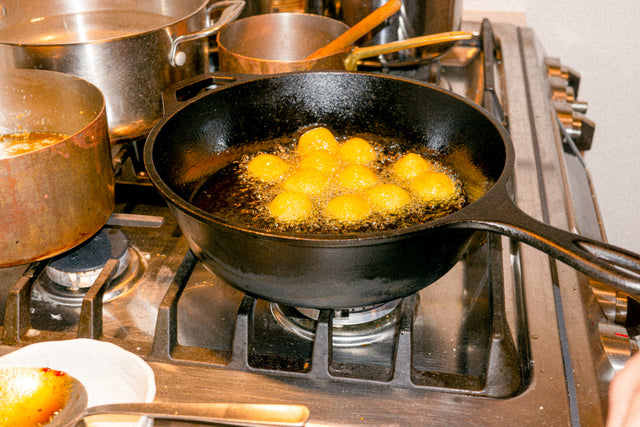
How To Reuse Fry Oil

Graza can handle the heat! Don't wanna let your Sizzle go to waste after frying up some tasty olive oily recipes? Here we'll share how to safely reuse (and eventually dispose of) your used fry oil.
Can Olive Oil Be Used for Frying?
You may have heard of a little thing called a "smoke point." A physical measurement defined by researchers as the temperature (under lab conditions) at which an oil begins to emit visible smoke when heated, "smoke points" are frequently cited as a reason to not use extra virgin olive oil at higher heats, like when frying.
However, recent research has shown that smoke point does not correlate with changes in the composition of oil as it heats up. This means that the moment an oil starts to smoke in the pan isn't really the best or most reliable indicator that an oil is unsafe or unhealthy to consume. Higher smoke point oils are often chemically refined (basically pre-cooked) to create a high smoke point and longer shelf life—even though this process involves stripping away those vital nutrients, neutralizing the flavor, and creating other chemical compounds linked to health issues.
TLDR: Sizzle is safe for frying away.
Instead, focus on oxidative stability, antioxidants, and level of refinement when looking for a fry-safe oil. Smoke point is more of a marketing mechanism than a health concern. An oil’s smoke point does not correlate to its performance and stability when heated.
Rather, the factors that predict an oil’s safety and stability at high heat are the percentage of polyunsaturated fats (the lower the better), and the extent to which the oil has been refined (the less the better). Olive oil is primarily made of monounsaturated fatty acids (MUFAs!), which contain only one double bond and are most stable at high temperatures. Sizzle and Drizzle are made from the Picual olive, which has a higher stability than other varietals when heated because of super high levels of MUFAs, antioxidants, and polyphenols. Extra virgin olive oil, which has a low concentration of polyunsaturated fat, and is not refined at all, proves to be the best (and tastiest we think!) oil for cooking.
And for what it's worth, Sizzle's smoke point is 410°, beating canola oil—a common recommendation for an ideal fry safe oil—by ten degrees. We recommend frying at home in a Dutch oven or other large pot with a heavy bottom, and using a candy or deep fry thermometer (this one from OXO is a great option!) to track the temperature of the oil.
Can Oil Be Reused Safely?
YES! Just let us tell you how. As olive oil lovers we go through a lotta oil—frying up tasty Drizzle donuts, Sizzle schnitzels, and more. But once you're done with the frying fun, pouring out a dutch oven's worth of used oil can feel like a foodie comedown (regardless of how many Sizzle & Drizzle refills you've got stockpiled in the cabinet) when it's still so packed with flavor.
That's why reusing your olive oil once (or maybe even twice) is great way to make the most of your Graza, and is also cost-effective. It all has to do with storing it properly, in a cool dark place away from oxygen, light, and heat.
How To Reuse Fry Oil
Cool it off. Once you're done frying, remove your frying pot from the heat and let the oil cool completely. Don't rush this step—oil takes a while to cool down, and oil burns (at worst) or warped tupperware (at best) are never fun. Crack a cold one, do the dishes, and circle back to your EVOO once it's come back to room temperature.
Filter the oil. Frying leaves behind fried matter (all those tasty crispy crunchy bits) that will burn when you reuse the oil, and leave behind an unpleasant flavor—they should be strained out as soon as possible! Pour the oil through a fine mesh sieve that has been lined with cheese cloth to filter them out.
Transfer to safe storage. Once you've strained the oil, transfer it to a clean container, like a mason jar or an empty squeeze bottle. Use a funnel to simplify the process and avoid spills. Then place the jar in a cold, dark space for storage, avoiding light and heat. That means not next to your oven or microwave! Inside the fridge or inside a cabinet far from heat sources are good options.
How Many Times Can I Reuse Fry Oil?
Once you've safely saved your fry oil, there are some things to keep in mind when you want to use it again.
Flavor matters. Oil soaks up the flavor of whatever you're frying, so be mindful of what you're choosing to fry in your reused oil (and what you used it cook in the first place). If you fried up onion rings in your oil yesterday, it's probably not a great idea to fry donuts in the same oil today. (But it would be a tasty way to add a little oomph to a schnitzel). Try to fry similar flavored foods in the same oil.
Safe reusing = 1-3 times max. Each time you reuse oil it breaks down just a bit more, eventually decomposing. Avoid this breakdown and preserve its nutritional power by only reusing your oil a maximum of three times.
Practice food safety. Always err on the side of caution and trust your gut. If your oil smells harshly acrid and very different to when you cracked open the bottle, or is cloudy or foamy, it's time to toss. And make sure to dispose of any fry oil that has been stored for over one month.
How Should I Dispose of Used Oil?
Never pour oil down the drain! Not only is it bad for your plumbing, it's bad for the environment. Once again, allow any oil you've used to cool completely before placing in a sealable container and throwing it away.
Or use this handy locator to find spots where you can recycle cooking oil in your area!
Wanna Read More About EVOO?
Check our more educational pieces about the great big world of olive oil on our Glog HERE! Or check out these books and sources that we recommend:
Extra Virginity by Tom Mueller - required reading for team Graza, a fascinating deep dive into the industry, history, and health benefits of olive oil
Smoke Point Not a Reliable Indicator of Cooking Oil Stability from the North American Olive Oil Association
Evaluation of Chemical and Physical Changes in Different Commercial Oils during Heating from ACTA Scientific Nutritional Health Journal
Refining Vegetable Oils: Chemical and Physical Refining by Said Gharby from The Scientific World Journal
Cooking with Olive Oil from the Olive Wellness Institute
What are MUFAs? from the Mayo Clinic

